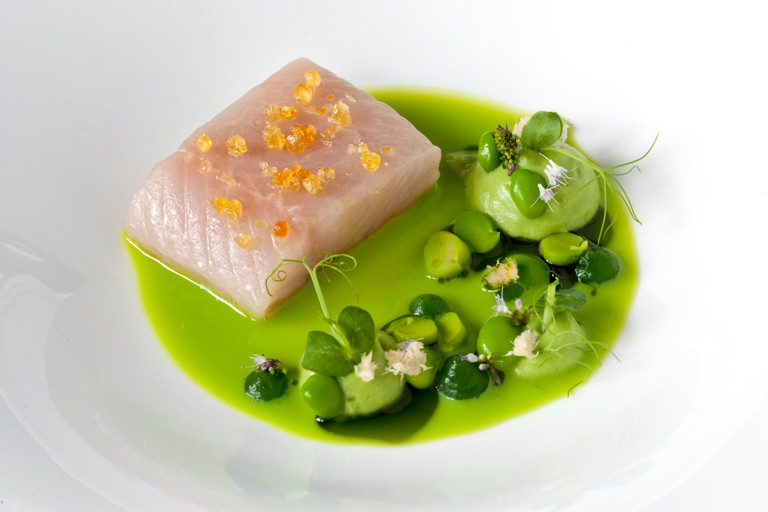Char from Val Passiria with peas and horseradish
Item 1 of 1
- 4
- 1 hour 20 minutes
This vibrant confit char recipe from Norbert Niederkofler is as much a celebration of the humble pea as it is the beautiful tender flesh of char, from a luscious pea cream to the beautiful pea shoot garnish. The chef even juices the pods to create a fresh pea stock.
First published in 2017
Ingredients
Metric
Imperial
Char and char caviar
- 240g of char fillet, Norbert uses char from Val Passiria
- 40g of char caviar
- grapeseed oil
Parsley oil
- 500g of parsley
- 150ml of rapeseed oil
Pea cream
- 1kg fresh peas, in the pod
- 50g of shallots, finely sliced
- 20g of butter
- 100ml of water
- 20ml of grapeseed oil
- 10g of fresh mint
- salt, to taste
Mint gel
- 30g of fresh mint
- 3g of agar agar
To garnish
- 50g of peas
- rocket flowers
- pea shoots
- fresh horseradish
SAVE RECIPE
Equipment
- Dehydrator
- Juicer
- Muslin cloth
- Food processor
- Microplane
- Squeezy bottle 3
Method
1
To begin, dry the char caviar in a dehydrator for 12 hours
- 40g of char caviar
2
To make parsley oil, clean and blanch the parsley and plunge into ice water. Transfer to a clean cloth and squeeze out any excess liquid
- 500g of parsley
3
Add the parsley to a blender with 75ml of oil and start blending. Gradually add the rest of the oil until it becomes a purée, then allow to stand in the fridge for 24 hours
- 150ml of rapeseed oil
4
The next day, pass through a fine sieve and transfer to a squeezy bottle. Use within 1 or 2 days of making for the most vibrant colour
5
To make the pea cream, separate the peas from the pods and set the pods aside for later. Blanch the peas in salted boiling water for 2 minutes, then refresh in iced water
- 1kg fresh peas, in the pod
6
Sauté the shallots in the butter until soft but without colour, then add the peas and cook briefly. Blend in a food processor with the mint at high speed, then blitz in the water and the grapeseed oil to make a nice smooth cream. Season with salt, pass through a fine sieve and transfer to a squeezy bottle
- 50g of shallots, finely sliced
- 20g of butter
- 20ml of grapeseed oil
- 10g of fresh mint
- salt, to taste
- 100ml of water
7
To make the pea stock, place the reserved pea pods in a juicer. Pass the resulting juice through muslin cloth to remove any impurities, then season with a little salt
8
For the mint gel, bring 300ml water to the boil, add the mint and cook for 10 minutes. Remove from the infusion and allow to cool (reserve the cooking liquid)
- 30g of fresh mint
9
Once the mint has cooled down, drain and squeeze well to remove any excess water. Mix the mint with the infusion in a food processor at high speed for about 1 minute then pass through muslin cloth
10
Bring 100ml of the liquid to the boil, add the agar agar and dissolve. Add the rest of the infusion then pour onto a baking tray and allow to cool for about 20 minutes until it sets. Once set, blend with a hand blender to obtain a smooth gel and transfer to a squeezy bottle
11
To repare the pea garnish, remove the skins from the shelled peas and lightly crush them between your fingers to split the peas. These will add a little crunch to your garnish
- 50g of peas
12
Now all of your elements are complete, it's time to cook the fish. Divide the char into 4 portions and pour the grapeseed oil over the fillets in a small but deep baking dish so they are completely covered. Cook in the oven at 60°C for 9 minutes (if your oven won't go that low, confit the char in a saucepan instead, using a cooking thermometer to keep the temperature consistent)
13
To plate, spoon some of the pea stock into bowls. Sprinkle the dried char eggs on top of the fish and place in the bowls to one side. Pipe on the pea cream and and mint gel and scatter the raw peas over the top. Using a microplane, grate over a little fresh horseradish and finish with the parsley oil, rocket flowers and pea shoot cress
Get in touch
Please sign in or register to send a comment to Great British Chefs.



